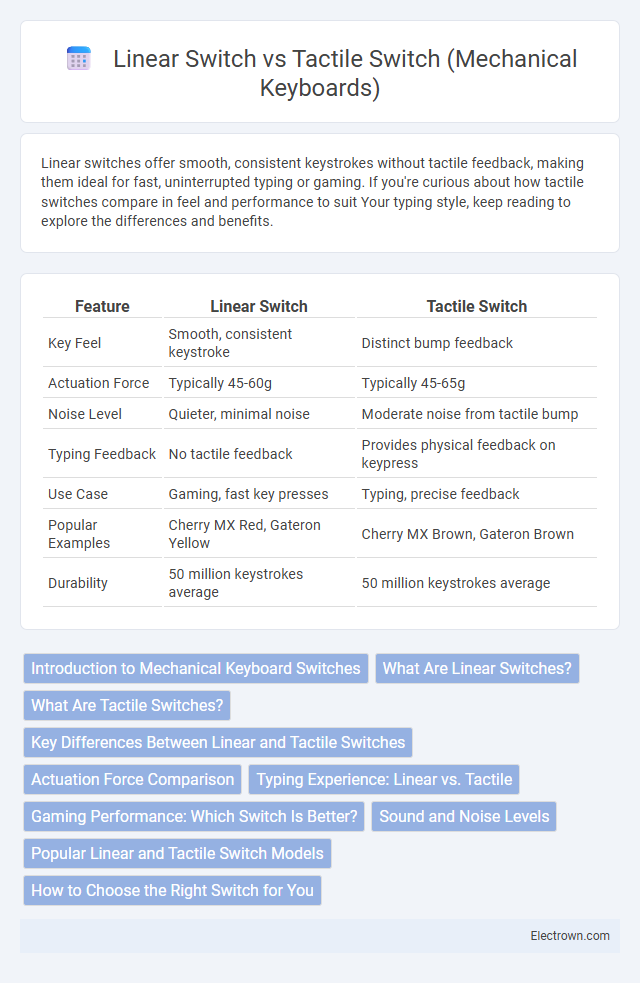Linear switches offer smooth, consistent keystrokes without tactile feedback, making them ideal for fast, uninterrupted typing or gaming. If you're curious about how tactile switches compare in feel and performance to suit Your typing style, keep reading to explore the differences and benefits.
Table of Comparison
| Feature | Linear Switch | Tactile Switch |
|---|---|---|
| Key Feel | Smooth, consistent keystroke | Distinct bump feedback |
| Actuation Force | Typically 45-60g | Typically 45-65g |
| Noise Level | Quieter, minimal noise | Moderate noise from tactile bump |
| Typing Feedback | No tactile feedback | Provides physical feedback on keypress |
| Use Case | Gaming, fast key presses | Typing, precise feedback |
| Popular Examples | Cherry MX Red, Gateron Yellow | Cherry MX Brown, Gateron Brown |
| Durability | 50 million keystrokes average | 50 million keystrokes average |
Introduction to Mechanical Keyboard Switches
Mechanical keyboard switches are essential components that define typing feel and performance, categorized mainly into linear and tactile types. Linear switches offer smooth, consistent keystrokes without tactile feedback, ideal for gamers seeking rapid actuation and quiet operation. Tactile switches provide a noticeable bump at actuation, enhancing typing accuracy and feedback for users who prioritize precision and tactile sensation.
What Are Linear Switches?
Linear switches in mechanical keyboards provide a smooth, consistent keystroke without tactile feedback or audible clicks, allowing for rapid and quiet key presses. These switches have a straightforward up-and-down motion, making them ideal for gamers and typists who prefer a fluid typing experience. Your choice between linear and tactile switches depends on whether you value simplicity and speed or prefer tactile bumps to confirm key activation.
What Are Tactile Switches?
Tactile switches in mechanical keyboards provide a noticeable bump at the actuation point, offering feedback without the loud click sound. These switches are preferred by typists and gamers who want to feel each keypress without bottoming out hard. Your typing accuracy and responsiveness improve with tactile switches due to the clear physical confirmation of key actuation.
Key Differences Between Linear and Tactile Switches
Linear switches provide smooth, consistent keystrokes without tactile feedback, making them ideal for rapid, uninterrupted typing or gaming. Tactile switches feature a noticeable bump before the key bottom, offering physical feedback to improve typing accuracy and reduce accidental key presses. Understanding these key differences can help you select the best mechanical switch for your typing style and performance needs.
Actuation Force Comparison
Linear switches require a consistent actuation force, typically ranging from 35 to 45 grams, providing a smooth keystroke without tactile feedback. Tactile switches have a noticeable bump, often requiring 45 to 60 grams of actuation force, offering physical feedback to signal key registration. This difference in force affects typing speed and accuracy depending on user preference for feedback and resistance.
Typing Experience: Linear vs. Tactile
Linear switches offer a smooth, consistent keystroke without any tactile feedback or audible click, making them ideal for users who prefer a quieter, more fluid typing experience. Tactile switches provide a noticeable bump at the actuation point, allowing Your fingers to feel each keypress, which can enhance typing accuracy and reduce fatigue during prolonged use. Choosing between linear and tactile switches depends on whether You prioritize smooth key travel or perceptible feedback for a more responsive typing rhythm.
Gaming Performance: Which Switch Is Better?
Linear switches offer smooth, consistent keystrokes with minimal resistance, making them ideal for rapid, repeated key presses in fast-paced gaming scenarios. Tactile switches provide a noticeable bump without an audible click, giving precise feedback that helps you avoid accidental key presses and improves accuracy in competitive games. For gamers prioritizing speed and fluidity, linear switches generally enhance performance, while tactile switches benefit those valuing control and responsive feedback during gameplay.
Sound and Noise Levels
Linear switches produce a consistent, smooth keystroke with minimal sound, making them ideal for quiet environments or shared workspaces. Tactile switches generate an audible click or bump, resulting in higher noise levels that provide feedback but may be distracting to others. Choosing between these switches depends on your preference for silence or tactile feedback during typing.
Popular Linear and Tactile Switch Models
Popular linear switch models include Cherry MX Red, Gateron Red, and Kailh Red, known for their smooth keystroke without tactile feedback. Notable tactile switches consist of Cherry MX Brown, Zealios V2, and Gateron Brown, offering a noticeable bump for precise typing without loud clicks. Both types cater to different preferences, with linear switches favored for gaming and tactile switches preferred for typing accuracy.
How to Choose the Right Switch for You
Choosing the right mechanical keyboard switch depends on your typing preference and usage scenario, focusing on linear switches for smooth, consistent keystrokes without tactile feedback, ideal for fast-paced gaming. Tactile switches provide a noticeable bump without an audible click, enhancing typing accuracy and feedback, making them suitable for typists seeking responsiveness. Consider your comfort and intended use to ensure your keyboard switch enhances your productivity and enjoyment.
Linear Switch vs Tactile Switch (Mechanical Keyboards) Infographic

 electrown.com
electrown.com